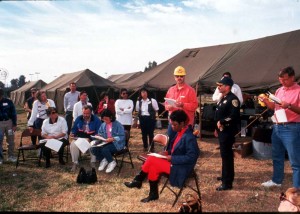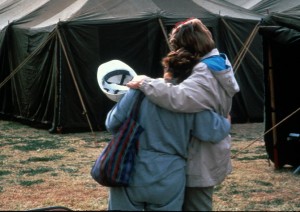University Library for California State University, Northridge
Susan Curzon, Dean of the Oviatt Library at California State University, Northridge, talks about the earthquake that affected the academic library in January 1994.
| Interview date: | June 27th, 2007 |
Questions:
(1.) What happened in your community (i.e., what was the disaster/emergency)?
| A 6.7 earthquake struck. The center was six miles from campus. Our Library was badly damaged. The Library had been built in two stages (1973 and 1991). The newer part had to be completely torn down and rebuilt. The older part had to have asbestos removal and a great deal of repair. During the six years between the earthquake and full returning to the building, we provided services partly out of the older part of the building, partly out of trailers, and partly out of plastic domes with concrete bases (Sprung Structures). The collection survived but rescue work was necessary because of rain and debris damage. It was very hard going for a long time first to find all of our personnel, rescue the collection, restore what services we could, set up temporary buildings, work on our new building, and document, document for FEMA. Some of our staff was also in very difficult circumstances with loss of their homes or considerable damage.
It is difficult to describe the unceasing labor that was necessary of so many but especially of someone like me as the dean of the library — my shoulder was to the wheel for years — the amount of effort, strategy, and work night and day is indescribable. I am sure it took years off my life. |
(2.) How did the library respond? How did the librarian respond? Were there non-traditional (unusual) roles that the librarian performed?
| We responded very well although it was a hard go. First, we had to figure out our new “landscape” and knew that nothing would be the same. Initially, a small group of us were standing in an open, muddy field in the rain. Most of the staff had to stay home for the first two weeks because there was nowhere for them to be on so dangerous a campus (hazmat conditions, asbestos, loose pillars, glass and debris everywhere, buildings unstable.)
I had a two pronged approach — first try to provide library service in any way that we could (because our President determined that we would start the semester on time no matter what) and then focus on restoring the building — the latter was very challenging because of the damage. The former very challenging because we had no library. The students and faculty voted for the library to be the number one building restored on campus. It really is impossible to run a university without a library. |
(3.) How has the library (or the services provided) changed as a result of these events?
| Well, at that time, libraries used technology but not on the scale of today. However, we really took a leap forward in the first year because we decided since everything had radically changed to just go ahead and make the changes we intended to anyway in our strategic plan. There was no point in going back. I am just glad we had a strategic plan we could implement.
I think the changes would have come in time anyway. However, most of our librarians and staff now were not here during the earthquake so the corporate memory of the event is slowly eroding. This was one reason why I wrote the Library Journal article so that somewhere our experience was recorded and with the urgency and voice of yesterday. |
(4.) What, in your opinion, are the roles for libraries (and librarians) in disaster planning, response and recovery efforts?
| Needless to say, I am not naive about disasters. The truth is you don’t know what the disaster will be, what the scale will be, what the impact will be, or even who will survive. You can do the best you can with having plans, having key people know the plans, having emergency training and emergency supplies but for the rest, we just have to survive on our wits and abilities. It does help to have a strong team going in though; the personality, courage and attitude of the individual were the most important factors - especially courage and a positive attitude.
I think in looking back that we do need to recognize post-traumatic stress more - it is far more powerful than people think. I think the campus started back too early; people should have been given time to get their homes and families in order. I do agree with the importance of starting that semester because people were terrified they would also lose their jobs. It was some months before we needed all of our staff, so they went to serve in any area they could, most especially in the Information Trailer (unfortunately with the name and number, “Trailer 666″). People were so happy to hear a live voice and someone who could actually help them. |
(5.) Photographs
| (1.) This shows structural damage to one of the steel support beams that supported the West Wing of the Oviatt Library. The severity of damage shown was typical throughout the Oviatt’s structure.
|
| (2.) & (3.) This shows the effects of the earthquake on the inside of the Oviatt Library. Books, furniture, etc… were thrown and scattered everywhere. |
| (4.) This photo shows the debris that fell from the Oviatt near the front entrance and portico. |
| (5.) Photo 5 shows earthquake damage to the rear side of the Oviatt Library. |
| (6.) After the earthquake, temporary tents were set up at the North end of the campus. Here meetings, communications, planning, first aid, security, etc. were coordinated as the campus began to recover and plan for the new semester. |
| (7.) The earthquake took quite an emotional toll on the members of the campus community. Here 2 people console each other up at the tent area during the first few days after the earthquake. |
| (8.) This photo depicts one of the many trailers that were set up after the earthquake on campus. They were used as temporary classrooms, office and meeting space, and storage. |














